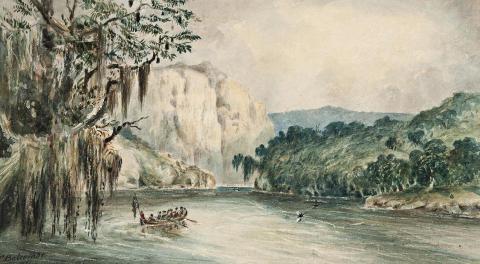THE RIVER GLENELG, 1836 – 1861
THOMAS BALCOMBE
watercolour on paper
17.0 x 30.5 cm
signed and dated lower left: T. Balcombe / 1861
Elliot family, New South Wales
Thence by descent
Private collection, New South Wales
Private collection, Melbourne
Mitchell, T.L., Three Expeditions Into the Interior of Eastern Australia: with descriptions of the recently explored region of Australia Felix, and of the present colony of New South Wales, T. & W. Boone, London, 1839, opp. p. 225 (illus., related engraving)
Thomas Balcombe joined the Surveyor-General’s Department, Sydney in 1830, as a draftsman under Major Thomas Mitchell. He was later promoted to field surveyor and remained in the department for the rest of his life. He joined Major Mitchell’s Third Expedition to the Murray River area in 1836 with Mitchell being the first European to discover (and name) the Glenelg River. The river is the longest in south-west Victoria stretching 350 kilometres from the Grampians to the coast at Discovery Bay, Nelson, near the South Australian border. The Glenelg was important to Indigenous Australians. It formed the traditional tribal boundaries for the nomadic Bungandidj people (western bank) and Gunditjmara people (eastern bank) both from two distinct language groups. Balcombe made sketches on the trip that formed the basis of later paintings such as our watercolour dated 1861. An engraving of the same subject appears in Mitchell’s published account of his explorations – Three Expeditions Into the Interior of Eastern Australia: with descriptions of the recently explored region of Australia Felix, and of the present colony of New South Wales, London, 1839 – with Major Mitchell cited as the artist. It is possible that this and other engravings illustrated in the publication and attributed to Mitchell were based on Thomas Balcombe’s expedition sketches.
